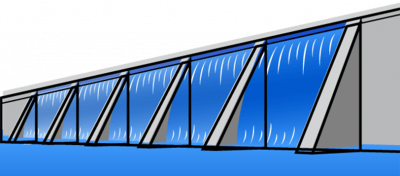Hydropower
Traditional hydropower changes a body of water so that the water’s flow can be used to generate electricity. For example, a dam may be built on a river to trap the water so it can be released through a turbine to generate electricity. Or, water can be pumped from a lower reservoir to a higher reservoir and stored there. When it is needed, it flows down through a turbine for electricity generation. Most traditional hydropower facilities are found in hilly or mountainous areas.
New hydropower uses energy from the natural movement of water to produce electricity without changing the water flow. For example, the constant flow of water in a river can spin the blades of underwater turbines to produce electricity.

- Hydropower produces no CO2 emissions and no air pollution.
- Dams create reservoirs that store water. They also make good locations for camping, swimming, and fishing.
- Dams control the flow of water and can prevent flooding.
- Hydropower depends on rainfall and snowmelt. Droughts can reduce power production.
- Dams can affect water quality and river flows.
- Dams can prevent fish from swimming up rivers to spawn or back to the ocean after breeding. This can reduce fish populations.

